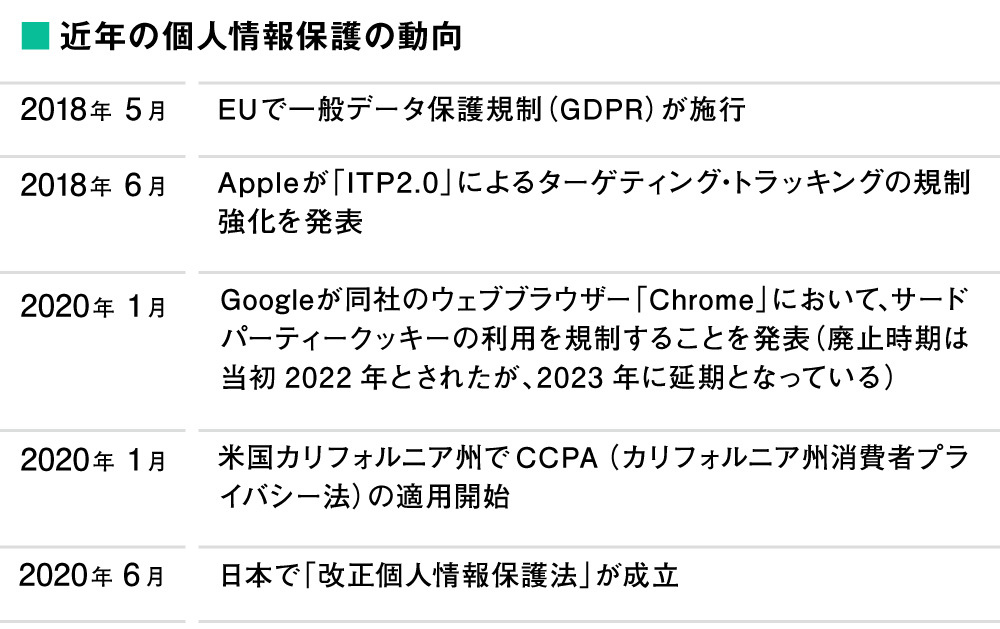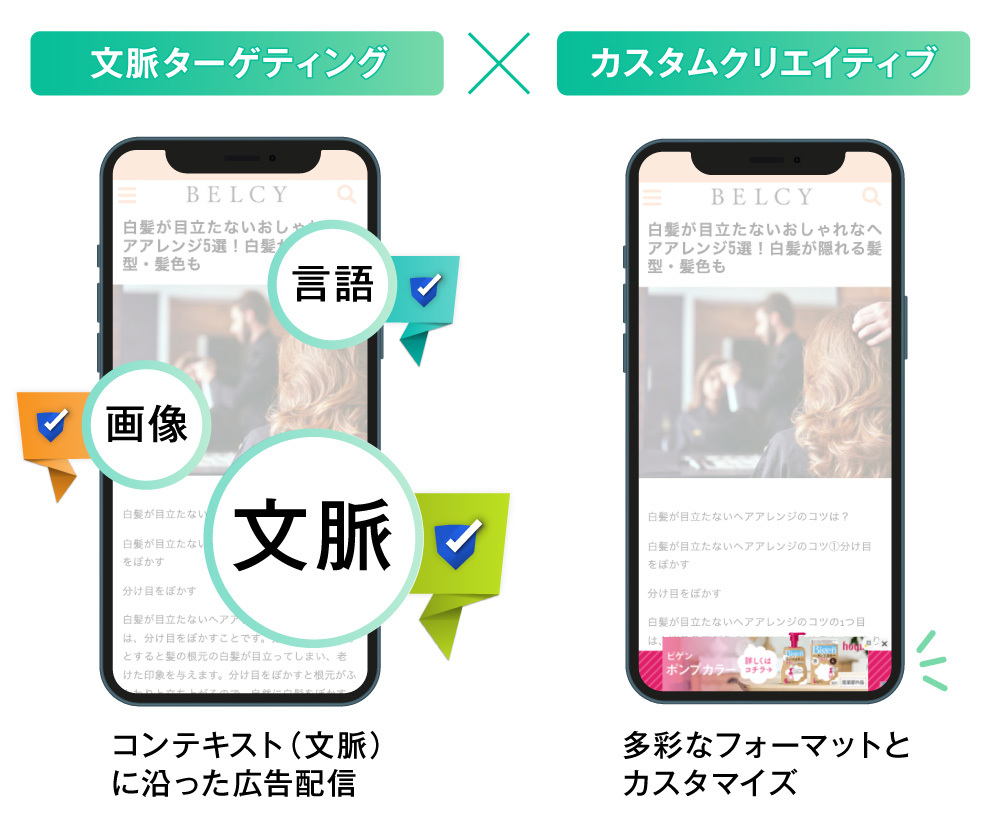Note: This website was automatically translated, so some terms or nuances may not be completely accurate.
Contextual Targeting: Astonishing Results! What is the Next Generation of Programmatic Advertising?
As the digital advertising world prepares for the "cookieless" era, various "post-cookie" solutions are gaining attention.
One such solution is contextual advertising (also known as context-based advertising or content-linked advertising). This programmatic advertising format leverages context analysis to place ads on media and content that match the brand, reaching consumers whose lifestyles align well with that brand.
■For more samples, visit the "GumGum Creative Gallery"
https://japan-gallery.gumgum.com/
※Switchable between PC browser view, smartphone view (portrait/landscape), and tablet view (portrait/landscape)
This series explores contextual advertising's groundbreaking features and effectiveness as a solution to the "cookieless" challenge plaguing corporate marketing and advertising professionals, using the efforts of GumGum Japan and Dentsu Inc.—top runners in contextual advertising—as examples.
In this first installment, Nobuyuki Onodera, who handles digital media planning for global clients at Dentsu Digital Inc., explains the latest landscape surrounding digital advertising and the fundamentals of contextual advertising.
<Table of Contents>
▼The Shift to "Cookieless" and "Anti-Tracking" in Programmatic Advertising: What's the New Countermeasure?
▼From Simple Targeting to Advertising That Captures Moments of User-Media Interaction
▼What New Value Does Contextual Advertising, Unbound by Traditional Metrics, Bring?
The Shift to "Cookieless" and "Anti-Tracking" in Programmatic Advertising: What's the New Countermeasure?
Amid rapid technological change, internet advertising has evolved from "slots" to "people," and from "reservation-based" to "programmatic."
By 2019, it clearly demonstrated its growth into a primary channel for corporate marketing activities, surpassing "TV media advertising spend" in Japan's total advertising expenditure.
However, in recent years, significant changes have begun to occur in the landscape of internet advertising, particularly in the realm of user privacy.
Programmatic advertising, which constitutes the majority of internet advertising, has relied on companies utilizing user data, represented by third-party cookies.
However, as momentum for personal information protection has grown, major platform companies that have driven the programmatic advertising market have begun steering toward restricting the use of third-party cookies for advertising.

Alongside stricter privacy regulations, restrictions on information usage within browsers have also intensified, forming a major current in today's internet advertising landscape. Specifically, the shift towards "cookieless" and "anti-tracking" approaches is accelerating.
In the post-cookie era, marketing will require a fundamental shift away from one-sided, company-centric information dissemination toward customer-centric marketing activities that prioritize the customer experience and build trust with consumers.
Amidst this, technology vendors are advancing the development and provision of "post-cookie" (anti-tracking countermeasure) solutions. Here are a few representative examples.
● Technologies and solutions gaining attention as alternatives to cookies
- Google's "FLoC" (Federated Learning of Cohorts), enabling targeting without identifying individuals
- Development and utilization of platform-specific advertising identifiers, such as Facebook's Conversion API (Amazon has also announced the development of its own identifier)
- "ID"-based solutions like The Trade Desk's "Unified ID"
- Ad delivery leveraging "context" (contextual analysis) from all data, including images and headlines, through AI analysis, exemplified by GumGum
This time, we introduce the fourth type: "Contextual Advertising."
From simple targeting to ads that capture consumer moments of media engagement
The previous section introduced four types of cookie replacement technologies. However, many of these technologies currently require significant development time from their respective vendors.
Amidst this, targeting that leverages "context" is gaining attention as a cookie replacement technology offering immediate effectiveness. While it's called targeting, it's not the same as the traditional approach based on third-party cookies that targets "people."
Instead, it identifies text, words, and image information within media content, analyzes the "context" of the article, and displays appropriate ads. This is " contextual advertising."
For example, imagine "cosmetic ads appearing on images or ad spaces within an article page about cosmetics."
A leading technology vendor in this "contextual targeting" field is GumGum. Founded in the US in 2008, it is a digital advertising technology company.
The company achieved rapid growth through highly accurate contextual advertising using its proprietary AI context analysis engine, "Verity." In 2017, it established GumGum Japan, entering the Japanese market. It is an advanced platform provider with significant achievements in the contextual advertising field.
This AI context analysis engine does not simply deliver ads based on the presence of cosmetic-related words in an article. While simple keyword matching could potentially place ads on negative articles, GumGum's Verity enables low-risk brand delivery through advanced context analysis.
As we face the post-cookie era, the company's context-targeting technology, with its immediate effectiveness, becomes a powerful option.
In practice, I implemented ad delivery using GumGum's solution for foreign clients in B2B and B2C sectors. Third-party measurement (3PAS measurement) showed that GumGum ads delivered higher effectiveness in metrics like "site visits" from impressions and clicks, and "transitions from site visits to cart pages," compared to campaigns using traditional cookie-based targeting.
Another strength of GumGum is its "rich creative optimized for contextual advertising." It customizes ad creatives to match the advertiser's desired contextual targeting, providing rich expressions distinct from traditional banners or videos, as seen in the gallery at the beginning.

This allows us to capture the "moment" for consumers and users visiting media or content while also capturing their "attention" with more impactful creative. The evolution of digital advertising through targeting has been described as "from slots to people," but we are now advancing a step further, entering an era that can be called "from people to moments."
In the recent ad delivery for the foreign client mentioned earlier, we implemented delivery using GumGum's contextual targeting combined with rich creative. This resulted in a CTR (click-through rate) more than double that of standard banner ads.
This result is likely due to the synergistic effect achieved by accurately capturing the media/content context while employing a rich advertising expression approach.
Contextual advertising also enhances brand suitability between media/content and creative, further boosting advertising effectiveness.
With the post-cookie era fast approaching, it's crucial to start experimenting now through trial and error to build knowledge. Waiting until stricter regulations take full effect to scramble for preparations risks significant delays and missed opportunities.
Moreover, in today's world, diverse media and content emerge every second, and the "moments" marketers must capture are constantly shifting.
For example, during the COVID-19 pandemic, there were trend spikes for words like "post-COVID," "living with COVID," and "new normal," but these terms may also fade from common usage at some point.
Establishing a flexible and responsive flow to capture these shifting "moments" and convert them into PDCA cycles for advertising activities will be a key challenge for future marketing. From this perspective, contextual advertising holds value as a solution capable of constantly adapting to the latest circumstances.
What new value does contextual advertising, unconstrained by traditional metrics, bring?
What kind of world does GumGum's industry-leading contextual advertising enable?
Some may view it simply as "a new option for programmatic advertising to replace third-party cookies, which will become unusable for ad delivery." However, as mentioned earlier, the true value of contextual advertising extends far beyond that.
Based on the information data within articles and context—the lifeblood of media—it creates communication through eye-catching branded ad creatives, delivered at the right moment to the very consumers and users reading that article (i.e., seeking information).
Contextual advertising has the potential to elevate engagement between companies and consumers/users beyond what traditional advertising effectiveness has achieved.

The author believes that advertising communication planning mindful of these three triggers will bring internet advertising back to its more fundamental essence.
What this means is that the one-dimensional approach to ad planning and effectiveness verification, which has primarily targeted "low CPC" and "low CPA" as key performance indicators for internet advertising, will become less sustainable going forward due to stricter anti-tracking measures and the arrival of the cookie-less era.
Furthermore, when evaluating advertising effectiveness holistically from perspectives like consumer/user LTV, brand safety, and ad fraud issues, it cannot be definitively stated that "cost-efficient ads" necessarily deliver the highest impact.
On the other hand, if contextual advertising enables consumer-first planning based on the "three triggers," it becomes possible to organically leverage the inherent functions and assets of media and advertising within communication.
This enables a return to the communication that truly delights consumers—the very purpose media and advertising were originally intended to achieve.
Was this article helpful?
Newsletter registration is here
We select and publish important news every day
For inquiries about this article
Author

Nobuyuki Onodera
Dentsu Digital Inc.
Account Planning Division, Global Accounts Business Unit
Chief Planner
Since 2012, I have led media communications (planning) and data alliances (CDP development, data connection/integration, etc.) for a wide range of clients—from brand to direct marketing—at domestic and international DSP/DMP/SSP vendors. I joined Dentsu Digital Inc. in 2019, where I have supported global companies' marketing activities in the domestic market to the present day.


